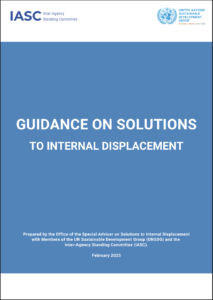 This Guidance on Solutions to Internal Displacement synthesises insights gained from two years of the mandate of the Special Adviser to the UN Secretary-General on Solutions to Internal Displacement. It offers guidance to Resident Coordinators (RCs) and Humanitarian Coordinators (HCs), UN Country Teams (UNCTs), Humanitarian Country Teams (HCTs), and partners on how to coordinate collective support to development-focused solutions to internal displacement. It emphasises the need to treat this phenomenon differently from the outset, including how the UN organises itself for this undertaking.
This Guidance on Solutions to Internal Displacement synthesises insights gained from two years of the mandate of the Special Adviser to the UN Secretary-General on Solutions to Internal Displacement. It offers guidance to Resident Coordinators (RCs) and Humanitarian Coordinators (HCs), UN Country Teams (UNCTs), Humanitarian Country Teams (HCTs), and partners on how to coordinate collective support to development-focused solutions to internal displacement. It emphasises the need to treat this phenomenon differently from the outset, including how the UN organises itself for this undertaking.
The Guidance introduces policies, strategies and financing models to promote development-oriented approaches and interventions for IDPs and wider displacement-affected communities, alongside continued humanitarian action. Importantly, it does not supersede but builds on, complements and should be read in tandem with the IASC Framework on Durable Solutions for Internally Displaced Persons (2010). It also draws on the IASC Management Response to the Independent Review of the Humanitarian Response to Internal Displacement, and builds on previous calls for more joined-up action amongst humanitarian, development and peace (HDP) actors that have yet to bring sufficient systematic change at the country level.
“This Guidance is based on early lessons, building on an immense body of work and experience that has come before this recent period of heightened effort. I believe it stands as a testament to our collective commitment to working together to turn the tide on internal displacement and support governments to build lasting solutions for millions of affected individuals and communities.”
– Robert Piper, Special Adviser to the UN Secretary-General on Solutions to Internal Displacement
JIPS contributed expertise and reviews to help inform this Guidance and support joined-up humanitarian, development, and peace responses in IDP contexts moving forward. JIPS continues to engage at the global level, feeding its experiences, lessons and best practices consolidated from its country-level engagement and support, to advance global standards, frameworks, and guidance and ensure that they are anchored in the realities on the ground.